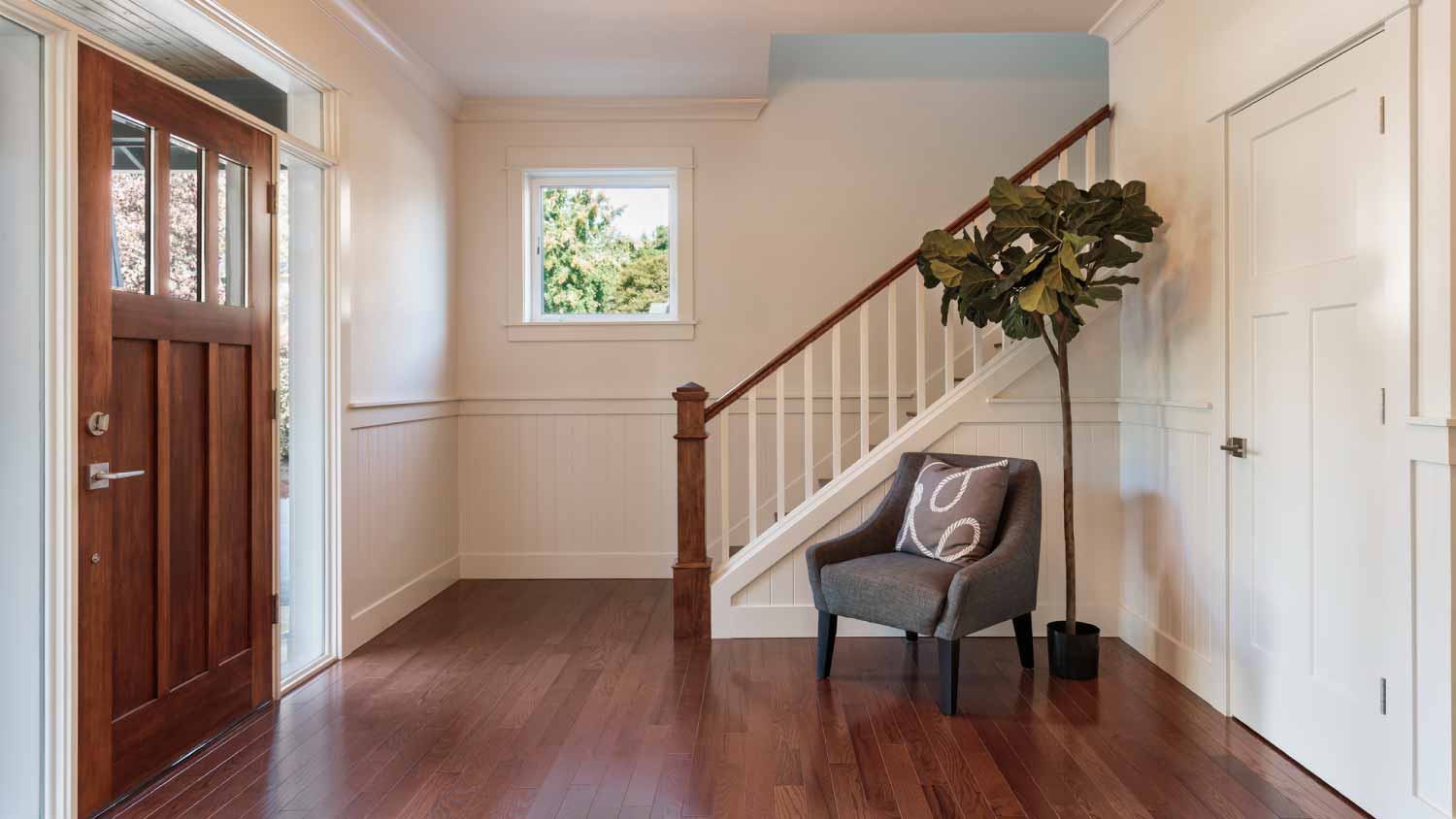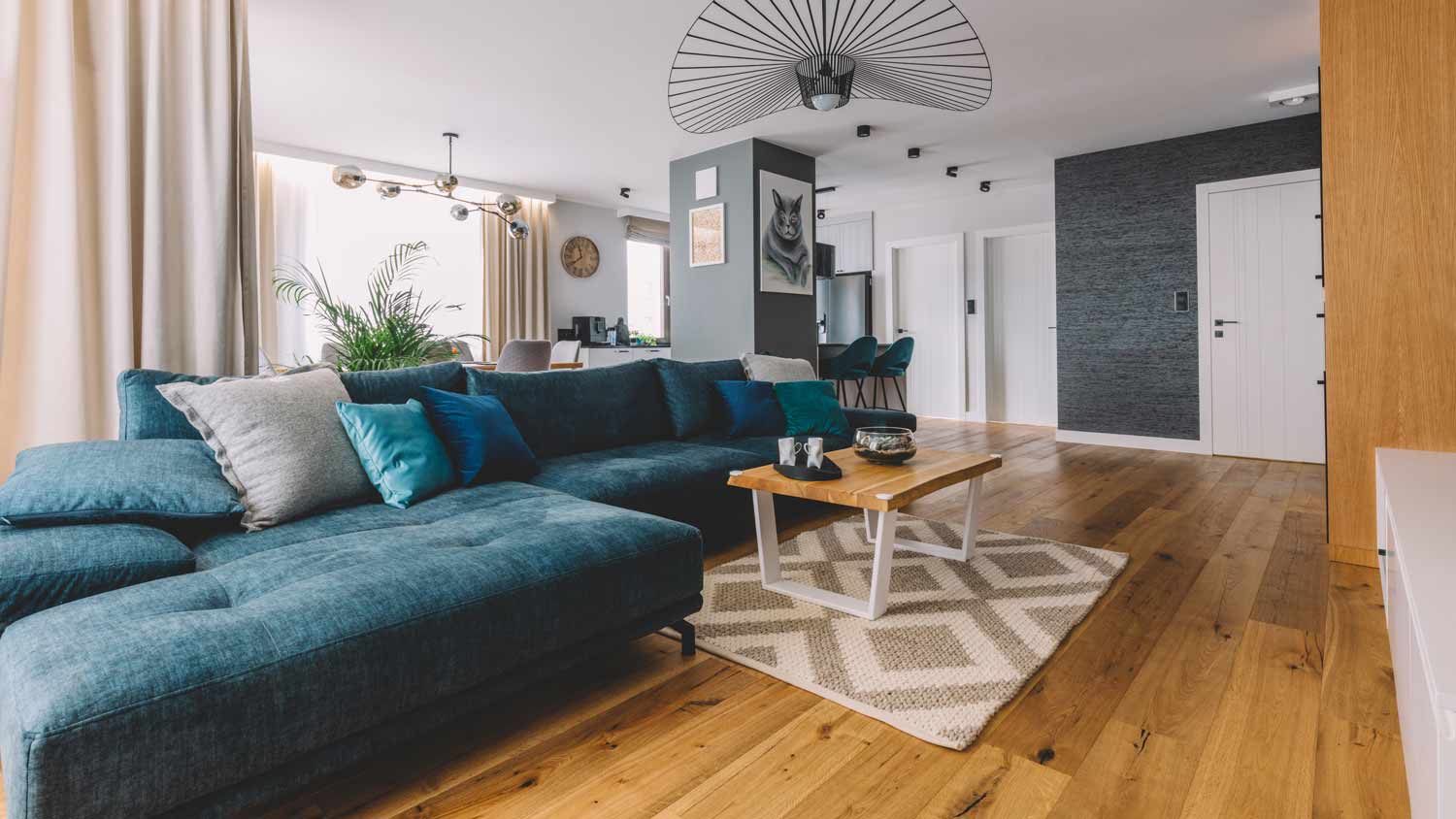How Much Does Laminate Floor Repair Cost? [2025 Data]
The average homeowner spends $1,250 on laminate floor repair costs. Depending on the type of damage, most spend between $393 and $2,121.


The average laminate floor repair cost is $1,250. It can cost as low as $150 or more than $5,000 if you need a partial replacement. It costs $3 to $11 per square foot to replace floor planks. Scuffs and scratches happen, especially if you have children and pets who are prone to turning your living room into a DIY racetrack.
Though laminate flooring is sturdy, something as small as a spilled cup of water could cause warped planks if you don’t wipe it up quickly. In that case, replacement is the only option. Here’s how the costs break down for laminate floor repairs.
Laminate Floor Repair Cost Breakdown
Most laminate floor repairs have a similar cost breakdown, with the main factors being the type of laminate, type of repair, and labor fees.
Type of Laminate
Laminate mimics the look of natural materials like hardwood flooring at an affordable price. That price is determined by the type of material, texture, finish, and abrasion coefficient rating (or AC rating). The AC rating measures durability and stain resistance, with higher levels having higher durability.
Expect to pay more to replace:
High-end imitations like hickory vs. common imitations like maple or oak
Textured laminate vs. smooth laminate
Glossy laminate vs. matte or semi-matte finishes
Laminate with a higher AC rating
Though you’ll pay more upfront to replace laminate with a high AC rating, you’ll spend less on repairs because it’s more durable. The same goes for glossy finishes and textured planks, which show fewer minor imperfections.
Type of Repair
The type of repair is the largest cost factor. You’ll spend less on a minor repair (like fixing a scratch or tiny gouge) than a larger repair (like replacing subflooring and fixing laminate with severe water damage).
Labor
Labor is often one of the highest laminate flooring costs because the actual material is relatively inexpensive. Local flooring contractors typically charge between $0.60 and $4.00 per square foot for their labor. In other words, if you’re replacing a 100-square-foot section of flood-damaged laminate, you could pay upwards of $400 just for labor.
Cost of Laminate Floor Repairs by Problem
You can repair laminate in a few different ways depending on the problem. Issues with the underlayment and subfloor come with a higher repair cost. Here are some common prices.

| Repair Type | Cost Range |
|---|---|
| Scratch or gouge | $100–$300 |
| Plank replacement | $3–$11 per square foot |
| Spacing | $300–$1,200 |
| Squeaky floor | $75–$300 |
| Floor bubbles | $3–$11 per square foot |
| Cupping | $250–$750 |
| Stains | $75–$300 |
Repairing Scratches and Gouges: You can use a DIY repair kit for less than $20 and fix small scratches and gouges in your laminate floor with furniture markers or wax filler. For larger scratches, a professional fix costs $100–$300.
Replacing Planks: Replacing damaged planks costs $3–$11 per square foot and typically costs more than $300, depending on the number of planks and how easy they are to remove. Deep cuts, cracks, and water damage are signs it’s time to replace them.
Redoing Spacing: A pro will need to redo the layout of your floor and potentially repair the subfloor or underlayment if your boards are warped or loose. Redoing spacing costs $300–$1,200.
Squeaky Laminate Floor: Issues with the subfloor, underlayment, or moisture cause squeaking floors. This fix costs $75–$300, and your contractor will use construction adhesive or screw down the problematic pieces.
Laminate Floor Bubbles: Water damage can cause bubbling in laminate floors. For larger bubbles, you’ll need to replace the tiles or planks, which costs 3–$11 per square foot.
Laminate Floor Cupping: It costs $250–$750 to repair a cupping laminate floor. If planks are sinking in the middle and peeling on the edges, there’s a moisture issue. You’ll need to replace the cupped tiles or planks.
Surface Stains: If you’re hiring a laminate floor cleaning company near you, expect to spend between $75–$300 to remove surface stains. Large stains take more time to remove, and some stains require removing and replacing the laminate.
Additional Costs to Consider
Laminate flooring consists of various parts, like subflooring, underlayment, or thresholds in your doorways. When you repair your floor, here are some extra costs to consider.
| Additional Factor | Cost Range |
|---|---|
| Threshold replacement | $100–$250 |
| Laminate painting | $250–$450 |
| Subfloor replacement | $1–$7 per square foot |
| Underlayment replacement | $0.29–$0.79 per square foot |
| Maintenance | $75–$175 |
Replacing Thresholds
For most homeowners, the cost to replace a threshold is between $100 and $250. Thresholds cover transitional areas like doorways are typically subject to heavy foot traffic. Over time, this can damage the laminate, and you’ll need to replace it.
Painting Laminate Floors
Most homeowners spend between $250 and $450 to paint laminate flooring in a standard 200-square-foot room. It depends on the size of the floor and the paint you use, but it’s a great way to save money if your floor is stained or scuffed and you don’t want to spring for a replacement.
Repairing or Replacing Subfloors
Repairing or replacing subfloors costs $1 to $7 per square foot, excluding labor, and most homeowners spend between $500 and $720. You’ll usually see plywood or OSB (oriented strand board) subfloors, and all laminate flooring has a subfloor. You may need to replace subfloors if you notice warping, water damage, or squeaky floors.
Replacing Underlayment
Laminate flooring requires an underlayment, which you might have to replace if there’s significant water damage. The underlayment helps support the floor, provides stability, and reduces noise. For the underlayment alone, expect to spend $0.29 to $0.79 per square foot. Labor costs depend on your contractor’s hourly price.
Maintenance
You’ll need to maintain your new floors. If you don’t want to clean your laminate floors, a professional cleaner generally costs $75 to $175 per visit, though costs can rise depending on the size of your home and location. Fix problems as soon as they appear rather than letting them progress to the point that you need to replace your floor.
Cost to Repair Laminate Flooring Yourself vs. Hiring a Pro

Homeowners who DIY their laminate floor repairs save on labor but can spend more money in the long run if mistakes are made. It may seem simple to swap out a plank from a click-and-lock style laminate floorboard, but even a small gap between laminate planks can harbor moisture that will ruin your laminate, underlayment, and subfloor.
Most homeowners can make smaller DIY repairs, like waxing over scratches and cleaning stains. Making minor repairs with a DIY kit can cost less than $20. The hardest part is matching the color of the marker or wax with your laminate.
As previously stated, professional labor adds $0.60 to $4.00 per square foot (or $25 to $30 per hour) to your budget. However, for larger repairs and replacements, it’s best to hire a laminate flooring repair company in your area to tackle the project.
4 Ways to Save on Laminate Flooring Repair Costs
Laminate is extremely durable, but it does have some weaknesses. It’s prone to water damage and minor scratches. These tips can help you extend the lifespan of your laminate and save on repair costs.
1. Practice Prevention
The best way to save on laminate floor repair is prevention. Put down rugs and carpets in high-traffic areas to avoid scratching the floor. Slip off high heels, boots, and heavier footwear. If you have to move furniture, lift instead of drag.
2. Clean Spills ASAP
Sometimes, there is use crying over spilled milk. Even a small spill can cause laminate flooring to bubble and warp. To prevent water damage, clean up spills as soon as they happen. You can also use a dehumidifier to lower your home’s overall humidity and remove moisture that might have leaked into the subfloor or underlayment.
3. Use a DIY Kit for Minor Repairs
A laminate touch-up kit is a great tool for fixing minor scratches, gouges, and marks. They cost less than $20 and are DIY-friendly.
4. Paint Your Floors for a Refresh
If your laminate floor is looking worse for wear but your subfloor and underlayment are in good condition, consider hiring a local painter to paint the laminate. This can hide discoloration and minor imperfections costs less than replacing all of the planks or tiles.
How Angi Gets Its Cost Data
Home is the most important place on earth, which is why Angi has helped more than 150 million homeowners transform their houses into homes they adore. To help homeowners with their next project, Angi provides readers with the most accurate cost data and upholds strict editorial standards. We survey real Angi customers about their project costs to develop the pricing data you see, so you can make the best decisions for you and your home. We pair this data with research from reputable sources, including the U.S. Bureau of Labor Statistics, academic journals, market studies, and interviews with industry experts—all to ensure our prices reflect real-world projects.
Want to help us improve our cost data? Send us a recent project quote to costquotes@angi.com. Quotes and personal information will not be shared publicly.
Frequently Asked Questions
Laminate is a sturdy material that lasts 15 to 25 years if it’s properly maintained and isn’t damaged. Laminate with a higher AC rating lasts longer than laminate with a lower AC rating. For the most longevity, put laminate with an AC1 rating in low-traffic areas and use laminate with an AC3 or AC4 rating in high-traffic areas like entryways.
Laminate isn’t the most forgiving material; you can only repair small scratches and gouges. For this reason, you should purchase a few extra planks when you first lay down your floor, so you don’t have to worry about trying to find a matching plank later down the line.
If water gets under your laminate floors, dry your floor immediately. Water that gets under the laminate planks soaks into the subfloor and can cause mold and warping. In that case, you may need to replace certain materials.
If the damage is severe, you’ll need to replace the underlayment and subfloor. Even if you’ve wiped up a spill, it’s a great idea to use a dehumidifier to remove excess moisture.


.jpg?impolicy=leadImage)












